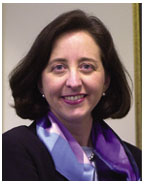
 Photo:
Janet Lavin Rapelye (frank wojciechowski)
Photo:
Janet Lavin Rapelye (frank wojciechowski)
This issue introduces alumni to Janet Lavin Rapelye, who takes over as dean of admission in July. As President Tilghman said in the news release announcing Rapelye’s appointment, there is no one more important than the dean of admission in shaping the future of Princeton.
The pressure likely to bear down on Rapelye could top even that felt by the thousands of students who vie for a “Yes!” letter from her new office. Now the dean of admission at Wellesley College, Rapelye joins Princeton just as the university prepares for a larger student body and as important issues in the world of college admission are coming together, including the proper role of race, athletics, and legacy in the decision process, and the value of early admission. Rapelye must confront all these issues – and she has to do it in the shadow of Fred Hargadon, who has become a legend among his peers.
Within an hour of the announcement of Rapelye’s appointment, a lively discussion began on at least one TigerNet discussion group. Some TigerNet posters lamented that another top position is being filled by a woman. (As of early April, Tilghman has named 11 new academic and corporate officers – of whom five are women. The new male officers are William B. Russel, dean of the Graduate School; Stan Allen *80, dean of the School of Architecture; Thomas Breidenthal, dean of religious life and of the chapel; Charles F. Kalmbach Jr. ’68 *72, senior vice president for administration; Brian J. McDonald ’83, vice president for development; and Peter G. McDonough, general counsel.) Other alumni suggested that, coming from a smaller college with fewer applicants than Princeton and without Division I athletics, Rapelye may be unprepared for the challenges of Princeton admissions. Some seemed to resent the fact that Rapelye comes to Princeton from an all-women’s school.
Yet Princeton and Wellesley share something important. As Wellesley’s dean, Rapelye has spent a great deal of time and thought working to dispel the “white gloves and pearls” image of her college. In this, she has been recognized for her success. No doubt, many students at Wellesley today – of all ethnicities – would not have felt at home in the Wellesley of the 1950s.
An obsolete image of Princeton also lingers. The university’s groundbreaking innovations in financial aid – which also are covered in this issue – help scrape away at that perception, but for some families, it remains. And while it is hard to imagine a better qualified applicant pool than Princeton already has, it seems a shame that some wonderfully talented students don’t consider this campus simply because they view it as a school for the wealthy.
“I think the histories [of Wellesley and Princeton] are important, and I think there are great strengths from those histories and those traditions,” Rapelye said in an interview with PAW. “But the world has changed, and these institutions have changed.” As admission dean, she said, she hopes to build on Princeton’s foundation and traditions, but also to show bright young people how the university has evolved.
So, welcome, Dean Rapelye. There are few issues that interest Princeton
alumni more than admissions. We hope that you soon will be able to speak
specifically about your plans and direction for your office. In the meantime,
we wish you good luck, and a thick skin.
![]()
![]()
